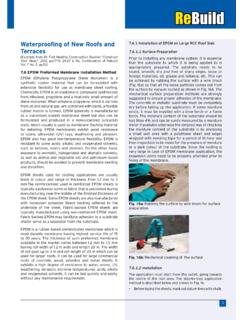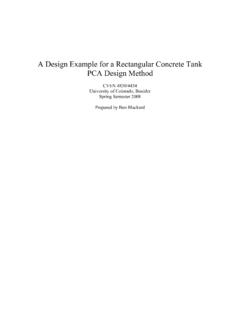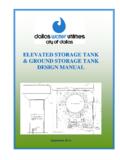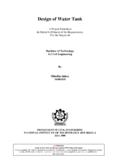Transcription of Waterproofing of Water Retaining Structures
1 Waterproofing of Water Retaining Structures [Excerpts from Dr. Fixit Healthy Construction Booklet Construct Your Ideas , 2012, pp. 14-15, 35] IntroductionDuring the construction of any Water Retaining Structures such as underground Water reservoirs or concrete swimming pools, etc., it is essential to ensure the Water -tightness of the resulting Structures so that the flow of Water from inside the structure to outside, and the infiltration of Water from the surrounding soil into the structure are effectively prevented.
2 Watertight concrete is achieved by a combination of selective materials, good workmanship and full attention to details both in design office and on site to ensure all Water containing and Water Retaining Structures should meet the strictest specifications from the conception to the design and finally the materialization of the are so many materials available for Waterproofing treatment, which are more efficient for Water -tightness. When it comes to the Waterproofing of swimming pools, constant hydrostatic pressure combined with rigid and porous structure of concrete pose serious challenges for an effective and lasting job.
3 Indian standards are not up to date with latest technology and material for Waterproofing of swimming pools & Water Retaining structure may be defined as a hydraulic structure designed to hold back, restrain, or obstruct the flow of Water . The treatment of a surface or structure to prevent passage of Water under hydrostatic pressure is known as Waterproofing of such Water Retaining Structures . The different Water Retaining Structures may be of following types: Swimming Pools Reservoirs / Water Treatment Structures underground Water Tanks Overhead Water Tanks Ponds, Water Features and Fountains Sewage Treatment design Consideration & PrecautionsSuitable precautions should be taken to avoid cracks and leakages in Water Retaining Structures resulting from the following.
4 Movements due to shrinkage and creep Movements due to variation of temperature and humidity Movements due to dissipation of heat generated by the concrete in the process of hydration Damage to the concrete by the percolation of chemically aggressive liquids from outside3 Damage due to uneven settlement of foundations Cracking of concrete caused by rusting of bars Hydrostatic uplift forceTo avoid temperature changes as far as possible, the Water tank should be built partly into the ground so that the soil is available to cover the roof, if necessary, and to form embankments on the outside so as to enclose the Water tank completely in a covering of earth.
5 Special precautions should be taken to guard against evaporation and the movements arising from extremes of temperature before the covering is design consideration should be made for serviceability, loads, design , durability and joints. In case of durability, the following points such as materials requirement, cementitious component, strength and W/C ratio, additives, embedements and curing components should be considered. Comparatively, in case of joints, the points need to be considered are types of joints, joint spacing, joint materials ( Water bars, fillers, sealants, bond breaker, reinforcement and dowels)
6 , joint design and joint construction Construction ConcretingThe first successful step in construction of Water Retaining Structures is to make a structurally integral protection system comprises of only the reinforced concrete structure that is designed to minimize Water penetration by the structure itself. The permeability of the concrete is reduced by introducing Water -reducing agents, high performance PCE (Polycarboxylate ether) superplasticizers, and pozzolanic products such as Silica-fume or Aluminosilicate, organic binders or pore blocking additives.
7 A good quality superplasticizer in the concrete mix is a solution of super plasticizing agent & additive in Water . It helps in achieving increased workability in all grades of concrete. The Water /cement ratio should between with a PCE based superplasticizer. This would reduce size, number and continuity of pores. Pore blockers such as silica fume acts as hydrophobic materials to line the concrete pores and thus reduce capillary absorption by altering the intermolecular forces in the system; concrete air Water .
8 The minimum and maximum cementitious contents in the mix should be 360 kg/m3 and 400 kg/m3 respectively. In case of Water Retaining Structures in aggressive environment Fly ash should be added by replacing 15-30% of OPC cement and in such cases 28-days compressive strength should be minimum 40 MPa and in normal environment minimum M30 grade of concrete is desirable. Maximum drying shrinkage at 28 days of in-situ concrete should be 420 microstrain. Apparent volume of permeable voids of hardened concrete should be less than 14%.
9 4 Internal vibrators should invariably be used, wherever possible. Vibrators should not be used for displacing concrete. Overloading the vibrators by placing too much concrete per vibrator is not good. Over vibrating by using too many vibrators relative to quantity of concrete also is not good. Segregation by excessive vibration or excessive Water content should be strictly avoided. Vibrator shall be withdrawn gradually and smoothly, and in a manner which shall not cause suction, voids or air cover is very important factor in all Water Retaining Structures .
10 In such Structures , the nominal cover to meet the durability requirement as per IS 456-2000 should not be less than 75 should be properly cured. Curing has an important influence on the permeability of concrete and it is necessary to keep the concrete moist, particularly during the first few days. Concrete synthesis, placement as well as curing practices should conform to the local regulations of concrete technology for Water resisting number and width is controlled from sufficient and properly placed steel reinforcement.

















